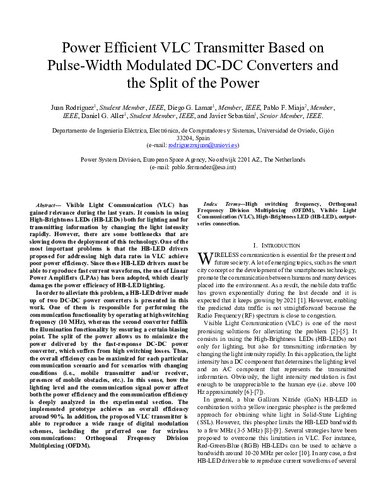Power Efficient VLC Transmitter Based on Pulse-Width Modulated DC-DC Converters and the Split of the Power
Palabra(s) clave:
High switching frequency
Orthogonal Frequency Division Multiplexing (OFDM)
Visible Light Communication (VLC)
High-Brightness LED (HB-LED)
Fecha de publicación:
Editorial:
IEEE
Versión del editor:
Citación:
Descripción física:
Resumen:
Visible Light Communication (VLC) has gained relevance during the last years. It consists in using High-Brightness LEDs (HB-LEDs) both for lighting and for transmitting information changing the light intensity rapidly. However, there are some bottlenecks that are slowing down the deployment of this technology. One of the most important problems is that the HB-LED drivers proposed for addressing high data rates in VLC achieve poor power efficiency. Since these HB-LED drivers must be able to reproduce fast current waveforms, the use of Linear Power Amplifiers (LPAs) has been adopted, which clearly damages the power efficiency of HB-LED lighting. In order to alleviate this problem, a HB-LED driver made up of two DC-DC power converters is presented in this work. One of them is responsible for performing the communication functionality by operating at high switching frequency (10 MHz), whereas the second converter fulfills the illumination functionality by ensuring a certain biasing point. The split of the power allows us to minimize the power delivered by the fast-response DC-DC power converter, which suffers from high switching losses. Thus, the overall efficiency can be maximized for each particular communication scenario and for scenarios with changing conditions
Visible Light Communication (VLC) has gained relevance during the last years. It consists in using High-Brightness LEDs (HB-LEDs) both for lighting and for transmitting information changing the light intensity rapidly. However, there are some bottlenecks that are slowing down the deployment of this technology. One of the most important problems is that the HB-LED drivers proposed for addressing high data rates in VLC achieve poor power efficiency. Since these HB-LED drivers must be able to reproduce fast current waveforms, the use of Linear Power Amplifiers (LPAs) has been adopted, which clearly damages the power efficiency of HB-LED lighting. In order to alleviate this problem, a HB-LED driver made up of two DC-DC power converters is presented in this work. One of them is responsible for performing the communication functionality by operating at high switching frequency (10 MHz), whereas the second converter fulfills the illumination functionality by ensuring a certain biasing point. The split of the power allows us to minimize the power delivered by the fast-response DC-DC power converter, which suffers from high switching losses. Thus, the overall efficiency can be maximized for each particular communication scenario and for scenarios with changing conditions
Patrocinado por:
Este trabajo cuenta con el apoyo del Gobierno español en el marco del Proyecto MINECO-17-DPI2016-75760-R, la beca FPU14 / 03268 y el Principado de Asturias en el marco del Proyecto FC-15-GRUPIN14-143, el Proyecto SV-PA-17 -RIS3-4, y subvenciones del Fondo Europeo de Desarrollo Regional (FEDER)
Colecciones
Ficheros en el ítem




